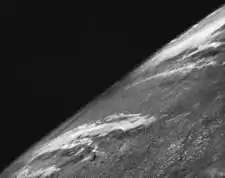V-2 No. 13
The V-2 No. 13[1] was a modified V-2 rocket that became the first object to take a photograph of the Earth from outer space.[2][3] Launched on 24 October 1946,[4] at the White Sands Missile Range in White Sands, New Mexico, the rocket reached a maximum altitude of 65 mi (105 km).[1][5]
 The first photo of the Earth above the Kármán line, taken with a motion picture camera aboard the V-2 No. 13. | |
| V-2 rocket launch | |
|---|---|
| Launch | 24 October 1946 |
| Pad | White Sands Missile Range |
| Outcome | Success |
| Apogee | 65 mi (105 km) |
| Components | |
| Serial no. | 13 |
The famous photograph was taken with an attached DeVry 35 mm black-and-white motion picture camera.[3][6]
See also
- Astrophotography
- First images of Earth from space
References
- White, L. (September 1952), Final Report, Project Hermes V-2 Missile Program, Report No. R52A0510, Schenectady, N.Y.: General Electric Company, retrieved 18 October 2016
- Air and Space article with photos
- Fraser, Lorence (1985). "High Altitude Research at the Applied Physics Laboratory in the 1940s" (PDF). Johns Hopkins APL Technical Digest. 6 (1): 92–99. Retrieved 18 October 2016.
- "Compendium of Meteorological Space Programs, Satellites, and Experiments" (PDF). NASA. March 1988. p. 10. Retrieved 22 October 2017.
- White Sands Missile Range Fact Sheet
- Beegs, Jr., William (30 July 2015). "Upper Air Rocket Summary 13". Archived from the original on 18 October 2016. Retrieved 18 October 2016.
This article is issued from Wikipedia. The text is licensed under Creative Commons - Attribution - Sharealike. Additional terms may apply for the media files.